Understanding and Managing Ants on the Ceiling
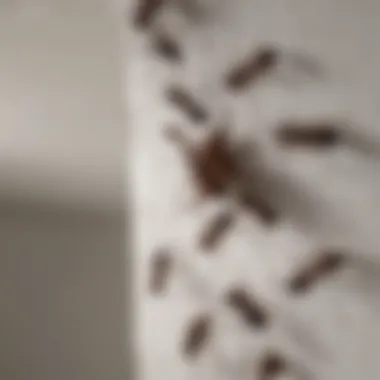
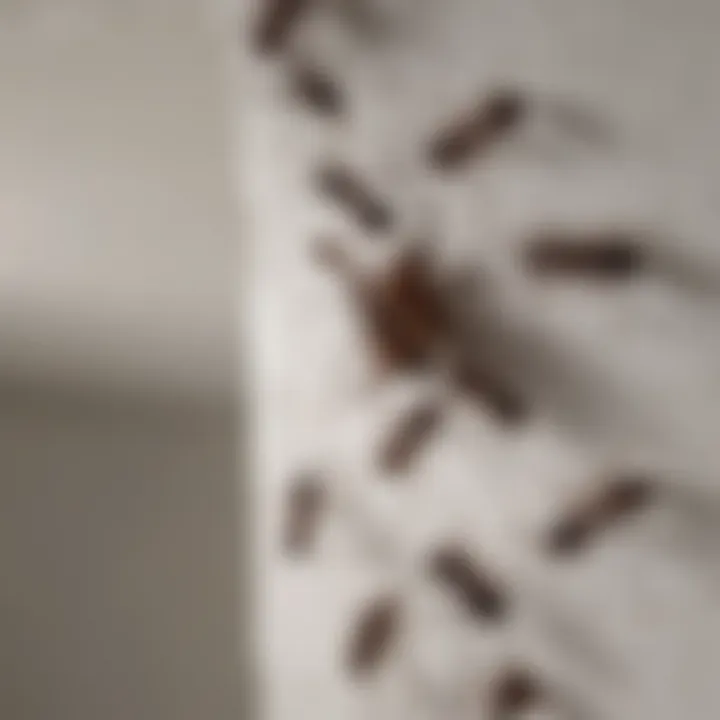
Intro
Ants are often thought of as outdoor insects. However, encountering them on the ceiling of your home or office can raise significant concerns. Understanding why ants invade indoor spaces is crucial for effective management. This guide will uncover the reasons behind ants on ceilings, their identification, behavior, and most importantly, how to prevent their spread.
Understanding the Pest
Identification
To effectively manage ants, one must first identify the species. Different ants have varied behaviors, and knowing which type is present is essential to choosing the right control methods. Common ceiling-dwelling ants include Carpenter ants and Sugar ants. Carpenter ants are typically larger and black or red in color, while Sugar ants are smaller and often reddish-brown.
Identifying ants can often be accomplished by observing their size, color, and movement patterns. Visual inspection of the colony can also reveal different castes within, such as workers and queens.
Life Cycle
Ants undergo a complete metamorphosis, which includes four stages: egg, larva, pupa, and adult. Each stage has significant implications for pest control. The queen lays eggs, which hatch into larvae. The worker ants care for these larvae, and eventually, they metamorphose into adults.
A single queen can lay thousands of eggs, leading to rapid population increases. Understanding this life cycle helps in timing treatment applications. For effective management, it is vital to disrupt the cycle before new adults emerge.
Pest Prevention Strategies
Environment Modification
The first line of defense against ants is modifying the environment. Ants can be attracted to food sources and shelter. Keeping kitchens and dining areas clean can reduce the chances of infestation.
- Seal cracks and crevices in walls.
- Store food in airtight containers.
- Remove standing water.
- Maintain clean surfaces.
By making your environment less inviting, you can significantly decrease the likelihood of ants taking up residence.
Physical Barriers
Another effective strategy includes using physical barriers to prevent access to ceilings. This can be done in several ways:
- Install weather stripping around doors and windows.
- Use fine mesh screens in vents.
- Close gaps around pipes and utility lines.
Creating physical barriers helps to limit where ants can go, particularly in multifamily dwellings.
Control Methods
Chemical Control
When prevention fails, chemical control may be necessary. Various insecticides are available that target ants specifically. It is essential to choose products labeled for ant control and to follow application instructions closely.
Common active ingredients include:
- Bait formulations with fipronil.
- Dusts containing boric acid.
- Sprays with pyrethroids.
Always consider the safety of household members and pets when using chemical control methods.
Biological Control
Biological control involves using natural predators to manage ant populations. Certain nematodes and microorganisms can be effective in limiting the growth of ant colonies. This approach is eco-friendly and poses fewer risks than traditional chemicals.
Consider integrating these methods if you are looking for more sustainable solutions to pest management.
Ultimately, understanding and managing ants on your ceiling demands attention to identification, behavioral traits, and environment. Successful control relies on implementing a combination of prevention strategies and control methods.
Intro to Ants on the Ceiling
The presence of ants on the ceiling within residential and commercial spaces is more than just a curious sight. It signals underlying issues related to pest control, environmental factors, and behavioral patterns specific to various ant species. Understanding why ants are drawn to ceilings, particularly in urban settings, is crucial for effective management and prevention strategies.
In this section, we will delve into the significance of recognizing ants in elevated locations. Ants are not merely unsightly nuisances; they can indicate a potential food source or nesting area nearby. Moreover, certain species may cause structural damage over time if their habits go unchecked. For homeowners and housewives, acknowledging these elements can lead to more proactive measures in maintaining a pest-free environment.
Key Considerations
- Behavioral Patterns: Identifying the specific behaviors of ants helps prevent infestations. Knowledge of how they migrate and establish nests is vital.
- Impact on Structure: Unmanaged ant populations can lead to long-term damage. Knowing this can motivate timely interventions.
- Health Concerns: Some ants can carry pathogens that affect food safety and overall hygiene in living spaces.
"An understanding of ant behavior is essential for effective pest management."
By understanding the dynamics that bring ants to ceilings, you can better grasp the importance of ongoing monitoring and appropriate control measures. This foundational knowledge sets the stage for more detailed discussions on ant behavior and their environmental preferences in the following sections.
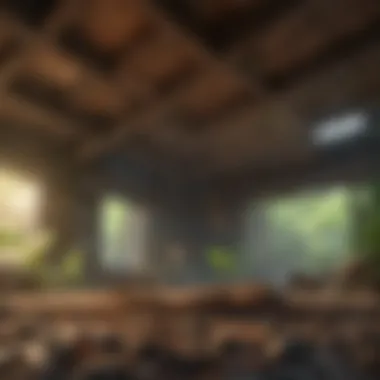

Ant Behavior and Habitat Preferences
Understanding the behavior and habitat preferences of ants is crucial when dealing with infestations. Recognizing these patterns can significantly aid in effective management and prevention strategies. This knowledge facilitates identifying when and where ants are more likely to invade, allowing homeowners to take proactive measures. By learning about species-specific traits, one can tailor solutions that are efficient and targeted.
General Ant Characteristics
Ants belong to the family Formicidae and exhibit social behavior. They live in colonies that can range from a few dozen individuals to millions. Key characteristics include:
- Body Structure: Ants have three main body parts: the head, thorax, and abdomen. They possess a distinct waist and two antennae for communication and navigation.
- Communication: Ants use pheromones for signaling within their colonies. This allows them to coordinate activities like foraging and defending their nest.
- Diet: Ants are omnivorous. They consume various substances, including sweets, proteins, and carbohydrates. Their feeding habits lead them into homes in search of food.
Understanding these basic characteristics can help identify suitable control methods.
Common Ant Species Found Indoors
Different species of ants inhabit residential and commercial spaces. Recognizing which species is present is vital for management. Common species include:
- Carpenter Ants: Known for nesting in wood, they can cause structural damage.
- Odorous House Ants: They emit a distinctive smell when crushed and prefer sweet substances.
- Pavement Ants: Often found outdoors but can invade homes, they are recognizable by their small size and are frequently attracted to food.
Identifying these common species can better inform control methods.
Nesting Habits and Ceilings
Nesting habits of ants greatly influence their presence on ceilings. Most ants prefer dark, sheltered places to build their nests. Key points to consider include:
- Location of Nests: Ants may nest within walls, ceilings, and under floors, leading them to travel through the indoor environment in search of food.
- Migration Patterns: During warm months, ants are more active and may venture higher in search for better conditions, exposing themselves on ceilings.
- Signs of Nesting: Look for small holes or frass, which may indicate a nest nearby.
Recognizing these nesting habits can help in preventing future infestations.
Why Are Ants on the Ceiling?
Understanding why ants appear on ceilings is crucial for effective pest management. Identifying the driving factors behind this behavior helps homeowners respond appropriately. As a diverse group of insects, ants have specific needs and behaviors that guide their movements. When they invade a home, knowing the reasons they choose elevation, particularly ceilings, can aid in developing targeted prevention strategies.
Searching for Food Sources
One of the primary reasons ants venture onto ceilings is the search for food. Ants have an acute sense of smell, enabling them to locate food sources from great distances. Once they establish a trail towards a food source, their colony members follow this path closely.
Common household food sources include:
- Sugar spills
- Crumbs beneath furniture
- Leftover pet food
- Open containers of food
The presence of food can attract various species, including Argentine ants, Odorous house ants, and Carpenter ants. Protecting your home requires thorough cleaning to remove potential food sources. Closing food containers and proper waste disposal is critical.
Environmental Factors
Environmental conditions also contribute significantly to ant behavior. Temperature and humidity levels within a home create ideal living conditions for ants. Most species prefer warmer, humid environments. As the weather changes outside, ants often invade homes in search of better conditions.
Key environmental considerations for ants:
- Consistent indoor warmth can attract ants during cooler months.
- Moisture around water leaks or excessive humidity creates suitable habitats.
- Direct access to the building's exterior allows ants to climb walls and reach ceilings.
By modifying indoor conditions, such as improving ventilation and repairing leaks, homeowners can deter these insects.
Impact of Seasonal Changes
Seasons greatly influence ant behavior and movement patterns. In spring, many ant colonies expand rapidly, scouting for food and nesting opportunities. Increased activity often results in sightings on ceilings and walls.
Moreover, during the summer, ants typically search for water and food. They may follow their trails to elevated locations where they might find these resources. As temperatures drop in autumn, ants seek shelter, often leading them indoors.
"Understanding the seasonal patterns of ant activity can empower homeowners to implement timely control measures."
Considering these factors helps preemptively address and mitigate ant infestations, establishing a pest-free environment.
Identifying Ant Infestations
Identifying ant infestations is crucial for effective management of these pests, particularly when they choose to inhabit ceilings in residential and commercial environments. Recognizing the early signs of an ant problem can prevent more significant issues later on. Ants, although small, can cause considerable damage to property and pose health risks by contaminating food sources. Understanding the signs can save homeowners both time and money.
Signs of an Ant Problem
Several indicators suggest the presence of ants within a space. Noticing these signs promptly can be beneficial in managing infestations efficiently.
- Visible Ants: The most straightforward sign is spotting ants themselves. Ants often appear in clusters, especially when foraging for food.
- Ant Trails: These are often visible along walls, ceilings, or floors where ants travel from their nest to food sources. These trails usually appear as a line of ants moving in a consistent direction.
- Nesting Sites: Look for small openings in walls or ceilings. Ants often build nests in these locations. If you notice any debris such as soil, wood shavings, or dead ants, this may indicate a nearby nest.
- Food Contamination: Check for small bites or holes in packaging of food items. Ants may invade pantries or cupboards, signaling a need to inspect further.
- Foul Odor: Some ant species, like Pharaoh ants, can emit a distinct odor when present in large numbers. This smell may resemble rotting fruits or a sweet scent.
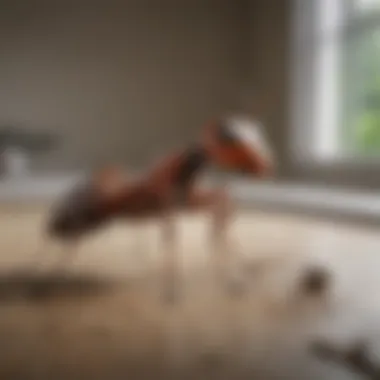
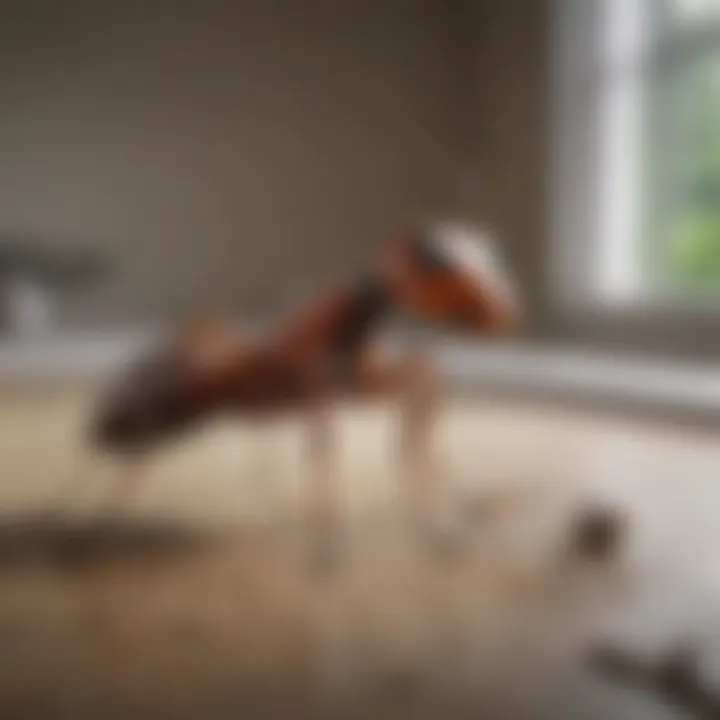
Being aware of these indicators allows homeowners to act quickly, possibly preventing larger infestations that may require professional intervention.
Ant Trails and Activity Patterns
Understanding ant trails and their activity patterns provides essential insights into the behavior and preferences of these insects. Ant trails are a common sight, especially in areas where food or water is available. Observing their movements can inform you about their nesting habits and help target control efforts effectively.
- Formation of Trails: Ants communicate through pheromones, leaving a scent trail for other ants to follow. If a food source is discovered, a trail will quickly form leading back to the nest.
- Regular Activity Patterns: Ant activity can change based on the time of the day. For example, many ants forage during the day, while some species, like carpenter ants, may be more active at night. To identify which species are present, observe their habits over a few days.
- Seasonal Variations: Recognize that ant activity can fluctuate with seasons. In warm weather, outdoor nests may lead ants indoors in search of food. Conversely, during the colder months, they may seek warmth inside homes, which impacts their travel patterns.
Understanding these activity patterns can assist in pinpointing the sources of infestations, allowing for targeted prevention strategies.
Recognizing the signs of ant infestations and understanding their behavior is essential for effective management. By being vigilant, homeowners can identify potential problems early and take appropriate action to protect their living spaces.
Exploring Control Techniques
Effective management of ants in ceilings requires a well-rounded approach, focusing on various control techniques. By exploring these methods, homeowners can minimize the impact of these pests while ensuring that their living spaces remain comfortable and free of infestations. Understanding these techniques not only helps in addressing current problems but also aids in preventing future occurrences.
Preventive Measures
Preventive measures play a crucial role in controlling ant infestations. It is essential to create an uninviting environment for these insects, discouraging them from establishing nests indoors. Here are some key preventive strategies:
- Seal Entry Points: Inspect your home thoroughly to identify cracks or openings that ants can use to gain access. Use caulk or weather stripping to seal these entry points effectively.
- Keep Clean: Regular cleaning routines help eliminate any potential food sources for ants. Pay special attention to kitchen surfaces, crumbs, and spills. Use airtight containers for food storage to further reduce accessibility.
- Remove Clutter: Clutter can provide hiding places for ants. Organizing spaces can help in reducing their shelter possibilities. Keep areas like closets and storage rooms tidy and decluttered.
- Regular Maintenance: Regularly check for signs of moisture in areas like attics and basements. Ants are often attracted to damp environments, so ensure that any leaks or water issues are addressed promptly.
Physical Barriers and Traps
Physical barriers and traps offer effective and often immediate solutions to control ant populations. These methods are particularly beneficial for those looking to avoid chemical solutions. Consider the following:
- Sticky Traps: Place sticky traps in areas where ants are commonly seen. These traps catch ants as they move, helping to monitor and reduce their numbers.
- Diatomaceous Earth: Sprinkling food-grade diatomaceous earth around potential entry points can deter ants. This natural powder damages their exoskeletons, leading to dehydration.
- Door Sweeps and Screens: Installing door sweeps and screens on windows can prevent ants from entering through these common entry points. Ensure that these are maintained well to avoid any breaches.
Chemical Solutions and Considerations
While seeking to control ants, some may consider chemical solutions. It is essential to use these with caution, given the potential risks to health and the environment. Here are some aspects to keep in mind:
- Insecticidal Baits: These products attract ants and deliver slow-acting poison that the ants carry back to their colony. This method targets the source of the infestation but requires patience for effective results.
- Sprays and Powders: There are various ant sprays available. However, it is crucial to choose those labeled as safe for indoor use. Read the instructions carefully and apply them in targeted areas to minimize unnecessary exposure.
- Professional Pest Control: In cases of persistent infestations, seeking professional help might be the best course of action. Pest control services often utilize specialized techniques and treatments that are more effective than common household methods.
"Effective pest management requires a balance between preventive measures, physical controls, and chemical solutions, tailored to the specific needs of your space."
By understanding and implementing these control techniques, homeowners can maintain a pest-free environment. The key is to combine various approaches and remain vigilant in monitoring for any signs of ants recurrence.
Eco-Friendly Pest Control Practices
Employing eco-friendly pest control practices is essential in addressing the issue of ants on the ceiling. Homeowners today seek methods that are not only effective against pests but also safe for their families, pets, and the environment. Traditional pest control methods often rely on harsh chemicals, which can pose health risks and lead to unintended consequences for local ecosystems. In contrast, eco-friendly practices prioritize sustainable solutions that mitigate ant infestations without compromising safety.
One notable benefit of eco-friendly pest control is the reduction of chemical exposure. This is particularly important for households with children or pets who may be more susceptible to health risks associated with toxins found in conventional pest control products. Additionally, eco-friendly methods often encourage the natural balance of the local ecosystem, allowing beneficial insects to thrive while targeting the unwanted ants.
However, it is crucial to understand the limitations of these methods. While they can be effective for managing small infestations, larger or persistent ant problems may still require more intensive measures. Keeping this in mind can lead to a balanced approach, using eco-friendly practices as the first line of defense.
Natural Repellents
Natural repellents offer a promising solution for deterring ants from invading indoor spaces. Ingredients such as vinegar, peppermint oil, and citrus extracts have proven effective in creating an inhospitable environment for these pests. For instance, a solution made with equal parts vinegar and water can be sprayed on surfaces where ants are seen. This not only masks scent trails left by the ants but also disrupts their communication.
- Vinegar: Effective at masking scents.
- Peppermint Oil: Acts as a strong repellent, with a pleasant smell for humans.
- Citrus Extracts: Ants dislike the smell of citrus, making it an excellent deterrent.
Using these natural repellents regularly can establish a deterrent effect, thus preventing ants from returning. Care must be taken to regularly refresh these solutions, ensuring their effectiveness over time.
Creating Unattractive Environments
Creating unattractive environments is another practical approach to manage ant populations. This method focuses on removing the elements that attract ants, such as food and shelter. To do this, homeowners should maintain cleanliness in their living spaces, ensuring that no food residue is left exposed.
Here are several considerations to keep in mind:
- Seal Food Containers: Use airtight containers to store food items.
- Regular Cleaning: Clean surfaces regularly to remove crumbs and spills.
- Check Plumbing: Repair leaky taps or pipes to minimize water sources that attract ants.
By making their homes less appealing to ants, individuals can significantly reduce the likelihood of infestations. This strategy, combined with natural repellents, creates a multi-faceted approach that enhances the effectiveness of eco-friendly pest management.
"Managing ants through eco-friendly practices not only safeguards your home but also supports a healthier planet."
In summary, adopting eco-friendly pest control practices allows for a more compassionate and sustainable approach to managing ant problems. By integrating natural repellents and creating unattractive living conditions, homeowners can effectively deter ants while also championing environmental responsibility.
The Role of Beneficial Insects
Beneficial insects play a significant role in maintaining the ecological balance within our environments. While most discussions about pest management focus on removal methods, it is essential to acknowledge the advantages these insects bring. They help manage ant populations, reducing the likelihood of infestations in both residential and commercial spaces.
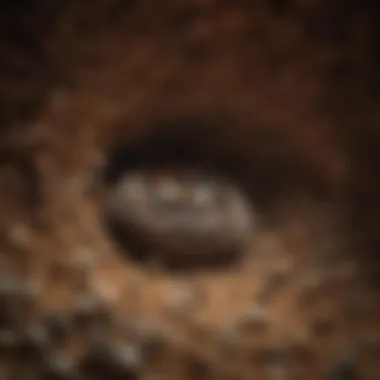
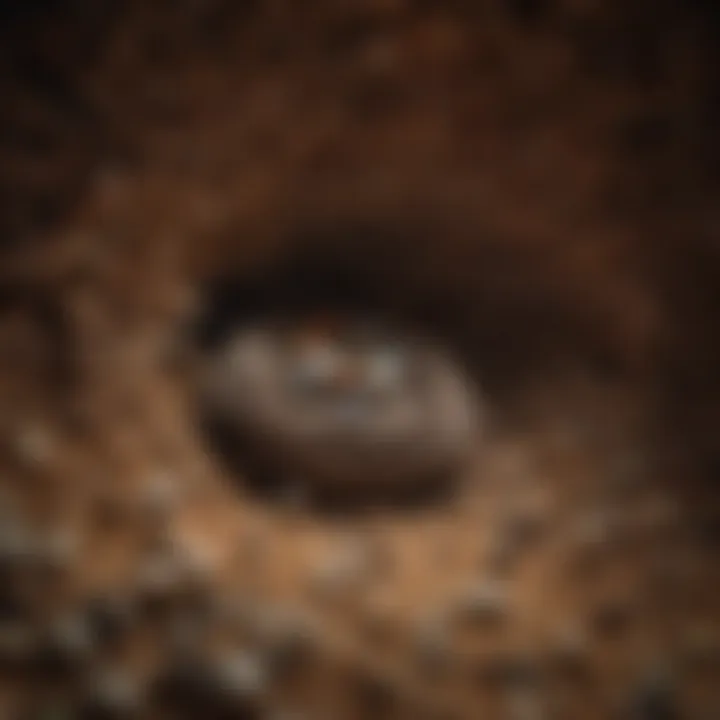
Predatory Insects
Predatory insects, such as ladybugs and lacewings, are vital allies in controlling ant populations. They prey on various insect species, including aphids and other pests that can attract ants. Ants often farm aphids for honeydew, so by introducing or preserving predatory insects in your garden or indoor plants, you can naturally reduce aphid populations and, subsequently, the ants that follow. This approach minimizes the need for chemical pesticides and encourages a balanced ecosystem.
Beneficial insects not only control pest populations but also enhance soil health. For example, some predatory insects improve soil aeration as they move through it in search of their prey. This contributes to a healthier growing environment for plants, making your space less appealing to ants looking for food sources.
Promoting Biodiversity
Promoting biodiversity within your surroundings is an effective strategy to manage pests like ants while fostering a healthy ecosystem. Creating an environment with a variety of plant species can attract beneficial insects, offering them the habitat they require to thrive. Native plants are particularly important since they support local beneficial insect populations.
Incorporating various plants can also help create a more resilient ecological system. For instance, flowering plants serve as a food source for many beneficial insects, increasing their numbers over time. A richer diversity ensures that beneficial insects can continue their role in suppressing unwanted pests, including ants. Additionally, maintaining a diverse garden setup can help prevent any one pest species from becoming too dominant, further limiting ant populations.
In summary, integrating beneficial insects into your pest management strategy allows for a more sustainable approach. By understanding their role in controlling ant populations and promoting biodiversity, you can effectively minimize infestations in an eco-friendly manner.
"Sustaining an ecosystem with beneficial insects not only addresses ant issues but also enhances your overall environment."
By embracing those principles, homeowners can enjoy a pest-free environment that also supports a variety of life beneath the surface.
Structural Concerns with Ant Infestations
Addressing structural concerns with ant infestations is crucial for both residential and commercial property owners. How ants interact with the structures of buildings can lead to issues that extend beyond mere annoyance. Understanding these dynamics can prevent significant damage and preserve the integrity of a home or business.
Potential Damage to Interiors
Ants can cause various forms of damage, affecting different areas of a structure. Common locations where damage may occur include:
- Wood Structures: Certain ant species, particularly carpenter ants, create nests within wooden structures. Their tunneling can weaken beams, ceilings, and wall studs, compromising the overall structural safety.
- Wall and Ceiling Finishes: Ants often travel in groups, leaving behind trails that might eventually stain walls or ceilings. This is not only an aesthetic issue but may also indicate deeper infestations that require remediation.
- Insulation: In search of nesting sites, ants can dislodge insulation, reducing its effectiveness and potentially increasing energy costs as a result. This can lead to higher heating and cooling expenses.
To avoid such damage, property owners should be vigilant. Regular inspections can help identify ant trails and potential nesting sites early on, reducing the chance of extensive damage.
Long-Term Implications
The long-term implications of ant infestations extend beyond immediate destruction. If not managed effectively, the following issues may arise:
- Increased Structural Repairs: As ants compromise wooden structures, the cost of repairs can escalate. Damages from carpenter ants may not be apparent until serious deterioration occurs, leading to expensive interventions.
- Reduced Property Value: A known ant infestation can diminish a property's appeal in the real estate market. Prospective buyers may hesitate if they learn of structural issues related to pest damage.
- Health Concerns: Ants can potentially carry pathogens or allergens into living spaces. While common household ants may not pose direct health risks, their presence can be unsettling. An infestation may lead to the growth of mold or other issues if moisture is trapped in structural components they infest.
"Understanding the impacts of ants on structural components is vital for preserving property integrity and ensuring safety."
Expert Advice and Recommendations
Understanding how to effectively manage ants on the ceiling requires insight and knowledge. This section is critical as it distills the expertise necessary for readers to make informed decisions regarding ant infestations in their homes. Expert advice provides practical strategies that are grounded in research and professional experiences.
When to Seek Professional Help
Recognizing the tipping point for when to call for professional help can save homeowners significant time and frustration. An infestation may escalate quickly, making self-management less effective. Signs indicating the need for a professional include:
- Severe infestations: When ant numbers are overwhelming, the problem may be beyond simple DIY remedies.
- Persistent issues: If conventional methods do not yield results after a few weeks.
- Potential for structural damage: Some ant species may cause damage to wooden structures. Early detection is key.
- Medical concerns: If certain ant species, such as fire ants, are present, their stings can provoke allergic reactions.
In these scenarios, seeking a professional pest control service becomes a necessary step to ensure thorough treatment and prevent re-infestation.
Choosing the Right Pest Control Service
Selecting an appropriate pest control service involves careful consideration. Not all services use the same methods or focus on eco-friendly practices. Here are some key elements to consider:
- Reputation: Research online reviews and ratings. This will provide perception on the service quality.
- Experience with ant infestations: Ensure the service has specific experience in dealing with the type of ants present in your space.
- Control methods: Inquire about the methods used. Are they aligned with your values? For instance, do they use eco-friendly solutions?
- Cost estimates: Request detailed quotes that outline potential expenses. Be cautious of services that undercut others significantly. This can point to a compromised service quality.
- Follow-up services: A good pest control service provides follow-up visits to ensure ant problems are resolved effectively.
Choosing wisely can lead to a more effective resolution of the ant problem while preserving the home environment.
"Taking the time to select the right pest control service can prevent future ant infestations and protect your living space from potential damage."
By addressing these considerations diligently, homeowners are better positioned to manage their ant issues with confidence.
Finale and Preventive Strategies
Summary of Key Points
- Recognizing Ant Behavior: Familiarity with ants' behavior helps in understanding their nesting habits and food-seeking patterns.
- Identifying Infestations: Early detection is crucial. Look for trails, droppings, and nests, particularly in areas near ceilings or high corners.
- Control Techniques: Employ a mix of physical barriers, eco-friendly traps, and, if necessary, chemical solutions tailored to the specific ant species.
- Eco-Friendly Practices: Utilize natural repellents, ensuring that pest control methods align with sustainable practices, benefitting both your family and the ecosystem.
- Professional Help: Know when it is prudent to consult pest control services, particularly for significant infestations that require expert strategies.
These points provide a structured approach to dealing with ants in your living spaces, ensuring long-term peace.
Maintaining a Pest-Free Environment
To maintain a pest-free environment, consider these strategies:
- Routine Inspections: Regular checks for food spills, leaks, and structural defects can deter infestations. Seal cracks and openings where ants might enter.
- Proper Food Storage: Keep food in airtight containers. Regularly clean areas where food is prepared or consumed.
- Landscape Management: Maintain your outdoor environment by trimming bushes and trees away from the building. This minimizes the access points for ants.
- Moisture Control: Fix leaky pipes and manage humidity levels, as ants are attracted to damp areas.
- Educate Family Members: Teach your household members about hygiene practices that deter pests.
By integrating these preventive measures into daily routines, homeowners can effectively reduce the likelihood of ant infestations, ensuring healthier living conditions.







